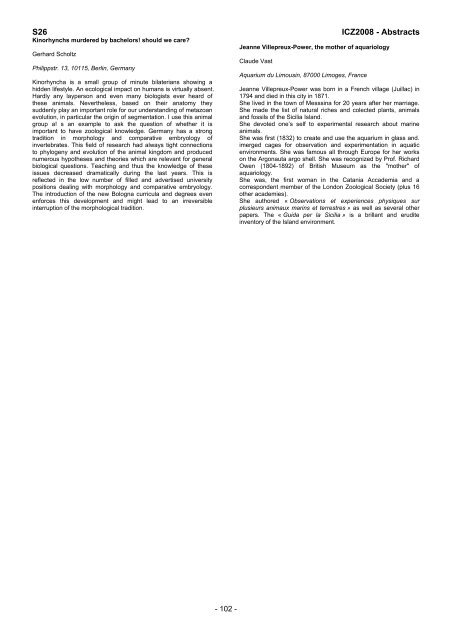CONTENT - International Society of Zoological Sciences
CONTENT - International Society of Zoological Sciences
CONTENT - International Society of Zoological Sciences
You also want an ePaper? Increase the reach of your titles
YUMPU automatically turns print PDFs into web optimized ePapers that Google loves.
S26 ICZ2008 - Abstracts<br />
Kinorhynchs murdered by bachelors! should we care?<br />
Gerhard Scholtz<br />
Philippstr. 13, 10115, Berlin, Germany<br />
Kinorhyncha is a small group <strong>of</strong> minute bilaterians showing a<br />
hidden lifestyle. An ecological impact on humans is virtually absent.<br />
Hardly any layperson and even many biologists ever heard <strong>of</strong><br />
these animals. Nevertheless, based on their anatomy they<br />
suddenly play an important role for our understanding <strong>of</strong> metazoan<br />
evolution, in particular the origin <strong>of</strong> segmentation. I use this animal<br />
group a! s an example to ask the question <strong>of</strong> whether it is<br />
important to have zoological knowledge. Germany has a strong<br />
tradition in morphology and comparative embryology <strong>of</strong><br />
invertebrates. This field <strong>of</strong> research had always tight connections<br />
to phylogeny and evolution <strong>of</strong> the animal kingdom and produced<br />
numerous hypotheses and theories which are relevant for general<br />
biological questions. Teaching and thus the knowledge <strong>of</strong> these<br />
issues decreased dramatically during the last years. This is<br />
reflected in the low number <strong>of</strong> filled and advertised university<br />
positions dealing with morphology and comparative embryology.<br />
The introduction <strong>of</strong> the new Bologna curricula and degrees even<br />
enforces this development and might lead to an irreversible<br />
interruption <strong>of</strong> the morphological tradition.<br />
- 102 -<br />
Jeanne Villepreux-Power, the mother <strong>of</strong> aquariology<br />
Claude Vast<br />
Aquarium du Limousin, 87000 Limoges, France<br />
Jeanne Villepreux-Power was born in a French village (Juillac) in<br />
1794 and died in this city in 1871.<br />
She lived in the town <strong>of</strong> Messsina for 20 years after her marriage.<br />
She made the list <strong>of</strong> natural riches and colected plants, animals<br />
and fossils <strong>of</strong> the Sicilia Island.<br />
She devoted one’s self to experimental research about marine<br />
animals.<br />
She was first (1832) to create and use the aquarium in glass and.<br />
imerged cages for observation and experimentation in aquatic<br />
environments. She was famous all through Europe for her works<br />
on the Argonauta argo shell. She was recognized by Pr<strong>of</strong>. Richard<br />
Owen (1804-1892) <strong>of</strong> British Museum as the "mother" <strong>of</strong><br />
aquariology.<br />
She was, the first woman in the Catania Accademia and a<br />
correspondent member <strong>of</strong> the London <strong>Zoological</strong> <strong>Society</strong> (plus 16<br />
other academies).<br />
She authored « Observations et experiences physiques sur<br />
plusieurs animaux marins et terrestres » as well as several other<br />
papers. The « Guida per la Sicilia » is a brillant and erudite<br />
inventory <strong>of</strong> the Island environment.


